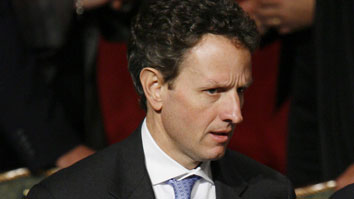You are currently browsing the tag archive for the ‘Dow Jones’ tag.
 Stock markets worldwide were gripped by fear as London’s FTSE 100 Index endured its worst week since the Black Monday crash of 1987.
Stock markets worldwide were gripped by fear as London’s FTSE 100 Index endured its worst week since the Black Monday crash of 1987.
Recession panic and concerns over fragile banks sent investors stampeding for the exits as the Footsie tumbled 8.9% – surpassing even Monday’s record sell-off.
The Footsie has plummeted 21% over the week – wiping more than £250 / $425 billion off the value of top-flight stocks in the process.
“another ugly day”
The index eventually finished below the 4,000 mark at 3932.1 – its lowest close for more than five years.
The 21% fall comes close to the 22% slide seen by London’s leading shares in the aftermath of Black Monday.
Following heavy overnight declines in Asia, screens turned red in the City as the London market approached falls of 10% at one stage. A dire start to US trading offered no respite.
The Dow Jones Industrial Average, which fell more than 7% on Thursday, tumbled as much as 8% during a volatile early session.
City watchers were confounded by the falls ahead of crisis talks among the G7 finance ministers this weekend. David Jones, chief market strategist at IG Index, called it “another ugly day”. “There is a real sense of despair… it is difficult to see what can be done to effect a handbrake turn in sentiment in the short term,” he said.
Across Europe, France’s CAC 40 and Germany’s Dax were also showing losses of 7% and 8% respectively amid the carnage.
In London, banking stocks were among the biggest victims of the turmoil as speculation mounted over the billions they may need to strengthen their finances. Royal Bank of Scotland lost 25% and is down a mammoth 61% this week, and Halifax Bank of Scotland fell 19%, and 37% over the week. Barclays tumbled 14%, making a 42% slump in the past seven days.
Source: Press Association

NEW YORK – Wall Street suffered through another traumatic session Monday, with the Dow Jones industrials plunging as much as 800 points and setting a new record for a one-day point drop as investors despaired that the credit crisis would take a heavy toll around the world. The Dow also fell below 10,000 for the first time since 2004, and all the major indexes fell about 5 percent.
The catalyst for the selling was the growing realization that the Bush administration’s $700 billion rescue plan and steps taken by other governments won’t work quickly to unfreeze the credit markets. Moreover, investors are increasingly unnerved by the paralysis in the credit markets that has started to affect companies trying to borrow for acquisitions or just to conduct their daily operations.
That sent stocks spiraling downward in the U.S., Europe and Asia, and drove investors to sink money into the relative safety of U.S. government debt. Fears about a global recession also caused oil to drop below $90 a barrel.
“The fact is, people are scared and the only thing they’re doing is selling,” said Ryan Detrick, senior technical strategist at Schaeffer’s Investment Research. “Investors are cleaning out portfolios and getting rid of everything because nothing seems to be working.”
The selling was so extreme that only 107 stocks rose on the NYSE — and 3,121 dropped. That’s a telling sign considering the stock market is considered a leading economic indicator, with investors tending to buy and sell based on where they believe the economy will be in six to nine months.






Recent Comments